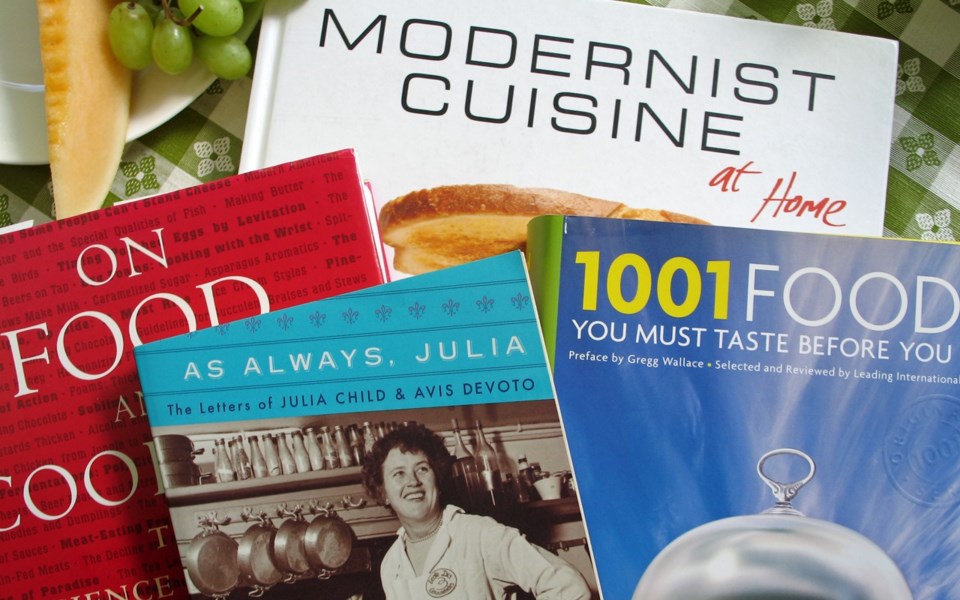Here's one more thing to thank the French for—that glorious summer invention, the picnic. While we can trace the concept of eating a lovely spread of food outside to late 17th-century France, it's a mystery where the original term, le pique-nique, came from. Most likely, it was a playful rhyming duplication of the French verb pique, meaning "to pick."
So pick a good spot, in dappled light, with no ants or wasps, something flat or slightly downhill for ease in stretching out. Pick easy dishes. Pick up the food with your fingers—no problem. And pick a good book to lazily feast upon when all that remains are rinds and empty bottles. (Remember? You left your iThing at home on purpose.)
Here are four favourite edible readables to gobble up this summer. But a quick scan of your local library will reveal more. Happy reading!
GO MODERNIST OR GO HOME
If ever there was a book about food to appeal to your inner scientist, artist and rebel as much as to your taste buds, it's Nathan Myhrvold's Modernist Cuisine at Home.
Offspring of the six-volume, 20-kilogram Modernist Cuisine: The Art and Science of Cooking, which first came out in 2011 and went for a hefty US$600, this one-volume tome, weighing in at 18 kilograms (40 pounds), is a summary for the home cook: The best of the bigger work that set the culinary world atwitter. A leisurely read is advised. With a 33-centimetre height and 52.5-cm wingspan, Modernist Cuisine is best enjoyed outspread on a picnic blanket.
The precise metrics, above, are intentional. For one, the recipes, in demanding precision of cooks and their outcomes, use weights as well as volumes and include handy scaling formulas to get things right when, say, doubling a recipe. As well, the book's creator and author, yet another Seattle-based overachiever (is it something in the water there?), studied math, geophysics and space physics—including quantum cosmology under Stephen Hawking—before zeroing in on culinary art and science.
Myhrvold sold his computer start-up to Microsoft before he turned 30, then became Microsoft's chief technology officer. He later earned a culinary diploma in France and founded Intellectual Ventures, which funds inventors and acquires patents, and The Cooking Lab—the research kitchen/lab behind the books.
A versatile facility replete with "scientists, research and development chefs, and a full editorial department," the lab also has some equipment I'd love to get my hands on. No. 1 is the laser cutter used to slice open everything from a sous vide cooker, shown complete with contents bubbling away inside, to an entire natural gas stove—sliced in two—to be photographed.
The powerful results are part of Modernist Cuisine's visual delight. From the instructional photos that make the striped mushroom omelette look like the Colonnes de Buren at Paris's Palais Royal to the painstaking close-ups of sautéed garlic and veggies, the photos and design are extraordinary. Mr. Myhrvold's appreciation of all things French is not lost on us, or the book.
The term "modernist" isn't taken lightly. In his intro, Myhrvold explains in a nutshell how modernism was a post-industrial rebellion, not just in painting but regarding any cultural undertaking. In an immodest comparison, he links Impressionism and its challenge to classical painting to his carefully-named "modernist cooking," which builds on Nouvelle cuisine of the '70s and is equally intent on busting open classical cooking. Rebellion as food.
Even if you don't make a single recipe from this book, take some time to browse. It will blow your mind if not your dinner menu.
MORE GOOD PICKINS
The thing about picnic reading is you're best not digesting heavy portions. Two more specials in that regard are Harold McGee's On Food and Cooking and 1001 Foods You Must Taste Before You Die. Both are great quick pickins.
Like Myhrvold, Harold McGee is a Cascadia Renaissance man steeped in art and science—only McGee studied literature and is based in San Francisco. His classic, On Food and Cooking, was first published in 1984. It went on to fascinate laypeople and professionals alike who were interested in the science behind food. To wit, Volume 1 of the original Modernist Cuisine cites McGee's work. Want to know how many flavour notes you can trace in grapefruit or the percentage of fat in 14 kinds of milk, including fin whale? Browse McGee.
As for 1001 Foods, hopefully you won't die anytime soon so you can check out these 1001 picks from around the world chosen by a handful of food professionals. From baba cake to partridge, each item is fleshed out through history, personal stories and great photos that make you want to explore more. Sure, the list is subjective and could include God knows how many other picks, but it's a great intro to foods from cultures you may not have known even existed. The pictures alone are worth it.
A TIMELESS MAIN COURSE
Michael J. Rosen has been involved in the creation of more than 150 books. I love what he said about James Thurber's work: "It allows us to appreciate both the times in which he wrote and our own time." I have to say the same about As Always, Julia: The Letters of Julia Child and Avis DeVoto. I'm usually not big on collections like this, but this is a winner. Julia and Avis met over their mutually shared search for the perfect paring knife. They eventually found one, but not before their 30-year friendship yielded the sharp wit and colour of decades of correspondence. It makes you appreciate both the times in which they wrote and our own time.
Glenda Bartosh is an award-winning journalist who loves picnics and books. She writes in this space every second week.




